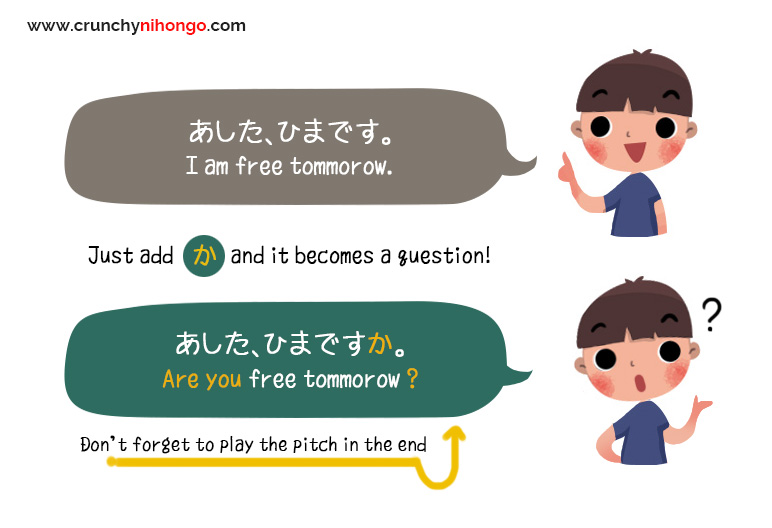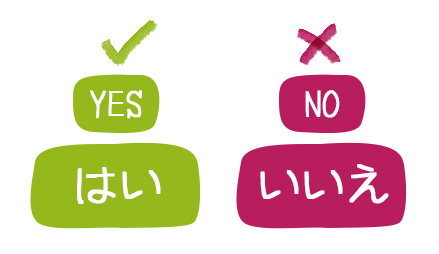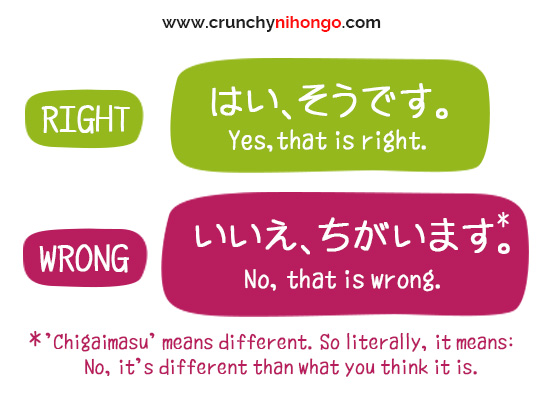Hi ! We hope this site helps you! ٩(ˊᗜˋ*)و As an Amazon Associate, we earn from qualifying purchases without additional cost. Click to read more about our Privacy Policy or Affiliate Disclosure
Quick links: Particle か | Constructing Sentence Using Question Word | Questions Words Lists | Answering Questions
…………………………………………
TURN SENTENCE TO QUESTIONS WITH PARTICLE か
Useful notes Don’t forget to play the pitch from low to high in the end though, so it sounds like a questions. It’s almost the same like when you play the pitch in English questions! Also note that usually the ‘?’ mark isn’t written in Japanese. You know it’s questions if it’s ended with か ‘ka’.


If there is no new topic introduced in the sentence or previous sentence, usually it’s safe to assume the sentence is about the speaker/hearer.
Super easy right!? Let’s move on!
…………………………………………
QUESTIONS WORDS
Before we learn about the questions words, you need to know that there are specific formulas to use question word in a sentence.
…………………………………………
Constructing sentence using questions words.
There are 2 type of construction. One is using は and the other is using が. Both will results in the same context so usually the translation in English will be the same and this cause confusion to basic learners. But just remember that
TYPE 1: [Topic] は、[Questions Word] か
In this type, you want to ask more information about a topic. Therefore you use は to mark the topic and use the questions word you need to gather information.
Useful notes To make it polite, add です before connecting it to か
[Kore] は [nan] desu かWhat is this?
Literally: About this…, what is it? [Ano hito] は [dare] desu か
Who is that person?
Literally: About that person…, who is it?
TYPE 2: [Questions Word] が, [what you want to confirm] か
In this type, you want to identify something, and so you don’t have any topic. Questions words cannot be a topic so you cannot use は. In this case, the connector is が.
[Dono hito] が [John-san desu] か?Which one is John?
Literally: Which person is John?
[Dore] が [Rin no hon desu] か?
Which one is Rin’s book?
Literally: Which is Rin’s book?
…………………………………………
Common confusions
Check out this example below:
A: [John] は [DARE] desu か
B: [DARE] が [John desu] か
Both translates as “Who is John”
Both have the same context, so the translations is the same, this usually cause confusion for basic learners. Which one to use? You can use either one. But the important thing to remember is the difference in sentence construction, when the question words is used in front, you must use が since a questions cannot be a topic 🙂
For the subtle difference between both, with は you make JOHN the topic, the focus is in John. So literally it means “About John…, who is he?” In が, it literally translate as “Who is John”. The focus is in the questions word use to identify John. Check out the link below to learn the subtle difference between は and が.
Related Somewhat Ultimate Guide to differentiate particle は and が
…………………………………………
JAPANESE QUESTIONS WORDS LISTS
We all familiar with English questions words, and here are the Japanese versions with their sample sentence.
1. WHAT: なに・なん
Example:
なにがほしいですか。What do you want ?
なんですか。What is it ?
…………………………………………
NANI or NAN ?
Written as a kanji 何, sometimes it’s read as NANI, sometimes as NAN. There are rules as to which one to use in a sentence and it’s written below. But I would recommend you not to think about it too much. It is something you will grasp naturally as the time goes by by seeing a lot of sentence sample.
なに
1. Used by itself. なに?means “What?”
2. If followed by noun. Such as Nani-IRO: What Color
なん
1. If followed by particle with consonant N, D, T (such as particle の/で/と) or followed by -だ/です。In all case other than these, we use NANI. Example: Nan-de / Nan-desu ka & Nani ga / Nani mo
2. When paired with counter
何人 (なんにん) : How many people
何時 (なんじ) : How many times
何回 (なんかい) : What time
Related Counting in Japanese *coming soon*
…………………………………………
WHO: だれ
Example:
あのひとはだれですか?。Who is that person ?
*A more polite version is どなた
…………………………………………
WHERE: どこ
Example:
ここはどこですか。Where is this?
どこにいきますか。Where will you go?
*In asking questions which involve movement of something/someone, we cannot use が, but we use another particle that identifies movements/positions, in this case, it uses に.
Related Particles that identify movement/positions *coming soon*
Another way to say WHERE is どちら. But this word also have another usage below:
1. Where/Which direction as in:
がっこうはどちらですか?
Where/Which direction is the school?
2. Which one of two things
Tanaka の ぼうしはぢちらですか?
Which one (of the two) is Tanaka’s hat?
3. Used in polite questions to ask the identity of someone. For example, to answer when someone is knocking on the door.
どちらさまですか
Who is it? Literally: Which person is it?
…………………………………………
WHY: どうして•なんで•なぜ
As in How come? For what reason ? Why? What’s the matter?
The different between those three words are in the politeness level.
なぜ – どうして – なんで
More polite — More casual.
It’s rare to use なぜ in standard conversations. If you were to pick one, どうして is good for general use. For casual use, you can just say the word with question intonation.
どうして?/ なんで?
To make it more polite, you can add ですか to all of them. And it won’t change the meaning.
どうしてですか / なんでですか / なぜですか
…………………………………………
WHICH:どれ
WHICH [noun] : どの [noun here]
John はどれですか。 Which (one) is John?
どのひとが John ですか。Which person is John?
Useful notes The difference is the same as in これ vs この. Both この and どの must be followed by noun.
Related Pointing things/places/locations (あ•そ•こ•ど words)
…………………………………………
WHEN: いつ
いつ、おわりますか。When will it ends?
To ask for time, we use 何+ counter for time (時)
今、何時ですか?
いま、なんじですか?
What time is it now? Literally: Now, what time?
To ask for what time does a store close/open, we need to use から (from) and まで (until)。
Q: このみせは、なんじからなんじまでか。
What time does this store open/close? Literally: About this store, from what time until what time?
A: ごぜんじゅうじからごごじゅうじまでです。
From 10 AM until 10 PM.
Related Counting in Japanese *coming soon*
…………………………………………
HOW
A. For How as in “How come?” we can use the same word as WHY, どうして•なんで
B. For How as in “How do you do that? How do you write it? How did you go here?” . To ask for the method/in what way something is done, we use どうやって
1. どうやってかきますか。How do you write it?
2. ぎょざはどうやってたべますか。How do you eat gyoza?
C. For How as in “How much money it cost” we use いくら
このさかなはいくらですか。How much is this fish?
D. For How as in “How is it? How are you feeling? What do you think?” we use どうですか
Example of usage: Think about a situation where someone offer you a cookies they made. After you eat it, they said どうですか? to ask “How is it? Is it good?”
Useful notes A more polite version used by salesperson or waiter is いかがですか。They will use it to offer you goods they sell or to give you recommendations. “How about this? What do you think about this?”
このほんはいかがですか?
How about this book? (Please take a look, see if you might like it)
E. For How as in “How many”, we use いくつ。
くるまはいくつおもちですか。How many cars do you have?
Useful notes The difference between いくつ and なん+counter is that this word is more formal. For example, both sentence below asking the same questions “How old are you?”. But using なんさい with older people might seems rude.
おいくつですか?(adding お increase the formality)
なんさいですか?(use it for someone younger than you)
…………………………………………
ANSWERING QUESTIONS
And now to answer questions.
1. YES OR NO QUESTIONS
First we will learn questions which can be answered with YES or NO. Here’s the word for YES or NO in Japanese.

It’s easier to learn by example, so take a look at the sample below:
Questions 1:
あさごはんはさかなをたべますか。
Do you eat fish for breakfast?
Reply:
はい、たべます。
Yes, (I) eat (fish for breakfast).
Useful notes When replying with NO, don’t forget to make your sentence negative too!
Questions 2:
らいげつ、アメリカへいきますか。
Will you go to America next month?
Reply:
いいえ、いけません。
No, (I am) not going
…………………………………………
2. Right or Wrong?
When asked something that related to noun, you can answer with this:

‘Chigaimasu’ means different. So literally, it means: No, it’s different than what you think it is.
…………………………………………
Q: このたてものはがっこうですか。Is that building a school?
A1: はい、そうです。Yes, that is right
A2: いいえ、ちがいます。びょういんです。No, that is wrong. (It’s) a hospital.
Important Don’t answer questions that related to adjective or verb with right or wrong only. You need to conjugate the adjective & verbs according to your answer. Check out samples below:
Q: しけんはむずかしいですか。Is the test difficult?
A1: はい、むずかしいです。Yes, it is difficult
A2: いいえ、むずかしくないです。No, it is not difficult.
…………………………………………
3. Choice Questions
When given a choice questions, you cannot answer with YES or NO.
This is quite logical. Think about a situation below:
Waiter: “Coffee or Tea sir?”
You: “Yes”
Waiter: “…” (staring at you awkwardly…)
So how to answer them? Here’s some example:
Q: リカさんはアメリカ人ですか、カナダ人ですか。Rika, are you American or Canadian?
A: アメリカ人です。(I am) American.
Useful notes You could say ‘Watashi WA Amerika-jin desu’. But both of you already know who you’re talking about so to make it natural it’s best that you drop the ‘Watashi WA’. Japanese loves to be vague and effective, so remove unnecessary elements to sound natural.
4. Answering Sentence Constructed Using Questions Words (Who/Why/How/etc)
Assuming that you already understand that there are 2 type of sentence constructed which has been explained above, it’s quite simple… if the sentence use は, you answer with は, and so on. Here’s an example below:

Q: あのひと は だれですか。 Who is that person? Literally: About that person, who is he/she?
A: あのひとは John-sanです。That person is John. Literally: About that person, he is John.

Q: どのひとが John-san ですか。Which person is John?
A: あのひとが John-san です。 That person is John
They look the same to me, what is the difference?
This part here only teach you how to reply them. If you’re wondering what is the difference between は and が used here, it’s just that in language you can have more than one way to say something. You can use either way but note the formula for each construction.
By using は, you are asking information about a topic. By using が, usually the topic is unknown, and you want to identify it using questions words.
For the complete list to differentiate particle は and が, check out this link below:
Related Somewhat Ultimate Guide to differentiate particle は and が
…………………………………………
All right, that’s about it!
Happy learning! 。゚✶ฺ.ヽ(*´∀`*)ノ.✶゚ฺ。

Your second example for yes/no questions about going to America uses the Japanese sentence about fish for breakfast. I think the question about if the building is a school is also missing the ‘で’ of ‘ですか’, but I could be mistaken. The rest of the article is great and very helpful, especially in explaining situational use. Thanks for all your hard work! <3
You’re welcome! and thank you very much for taking your time to let me know about the typo & errors, Ocianne! All has been fixed thanks to you~ *hug*
konnishiwa ajimashite watashi wa ismael but can help me to learn any langguade in japanese
You can use this site to learn more Japanese 😀